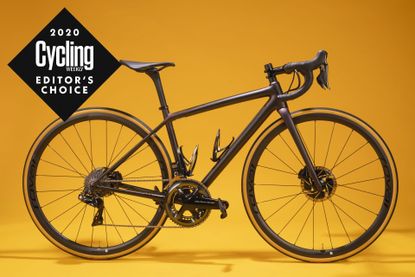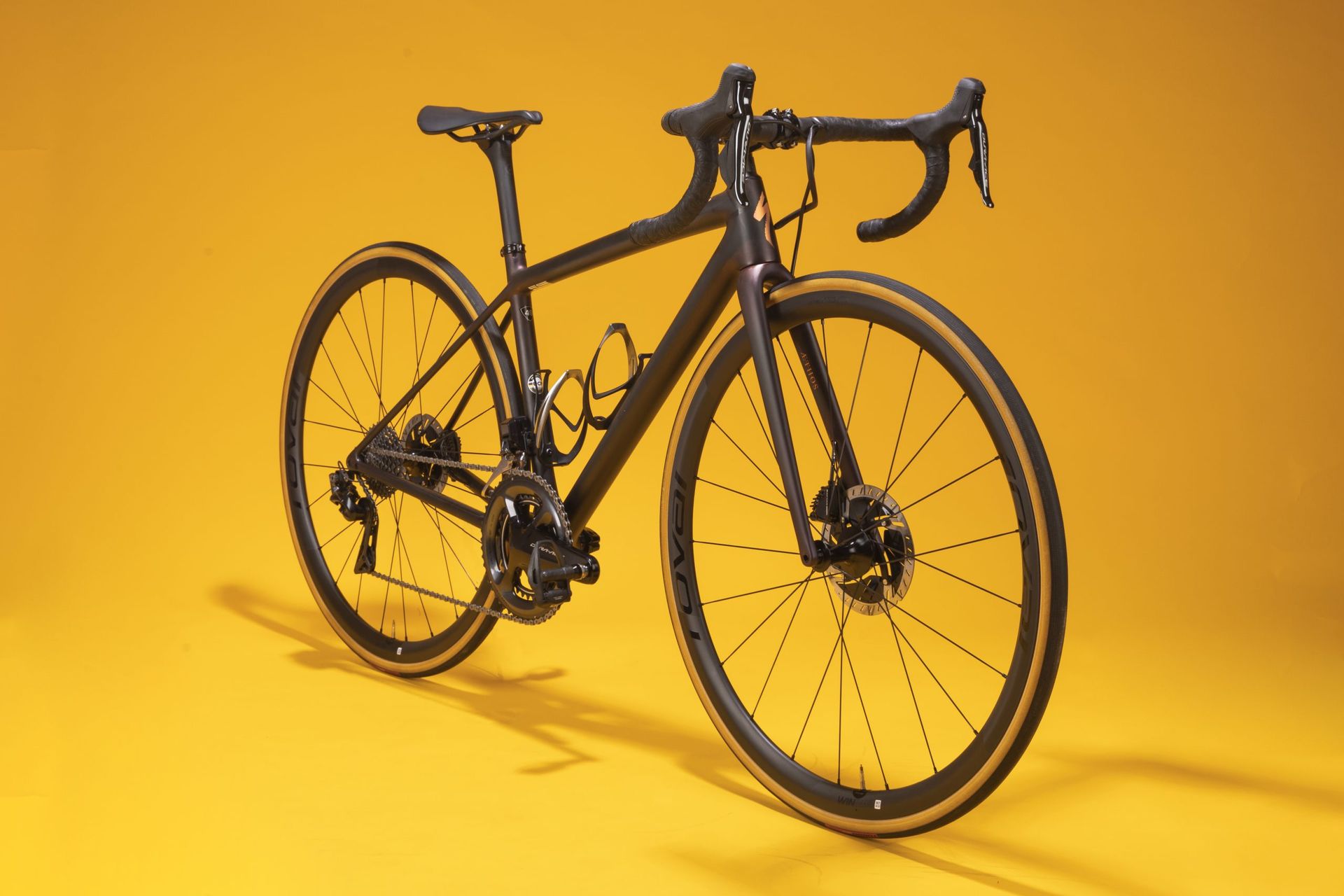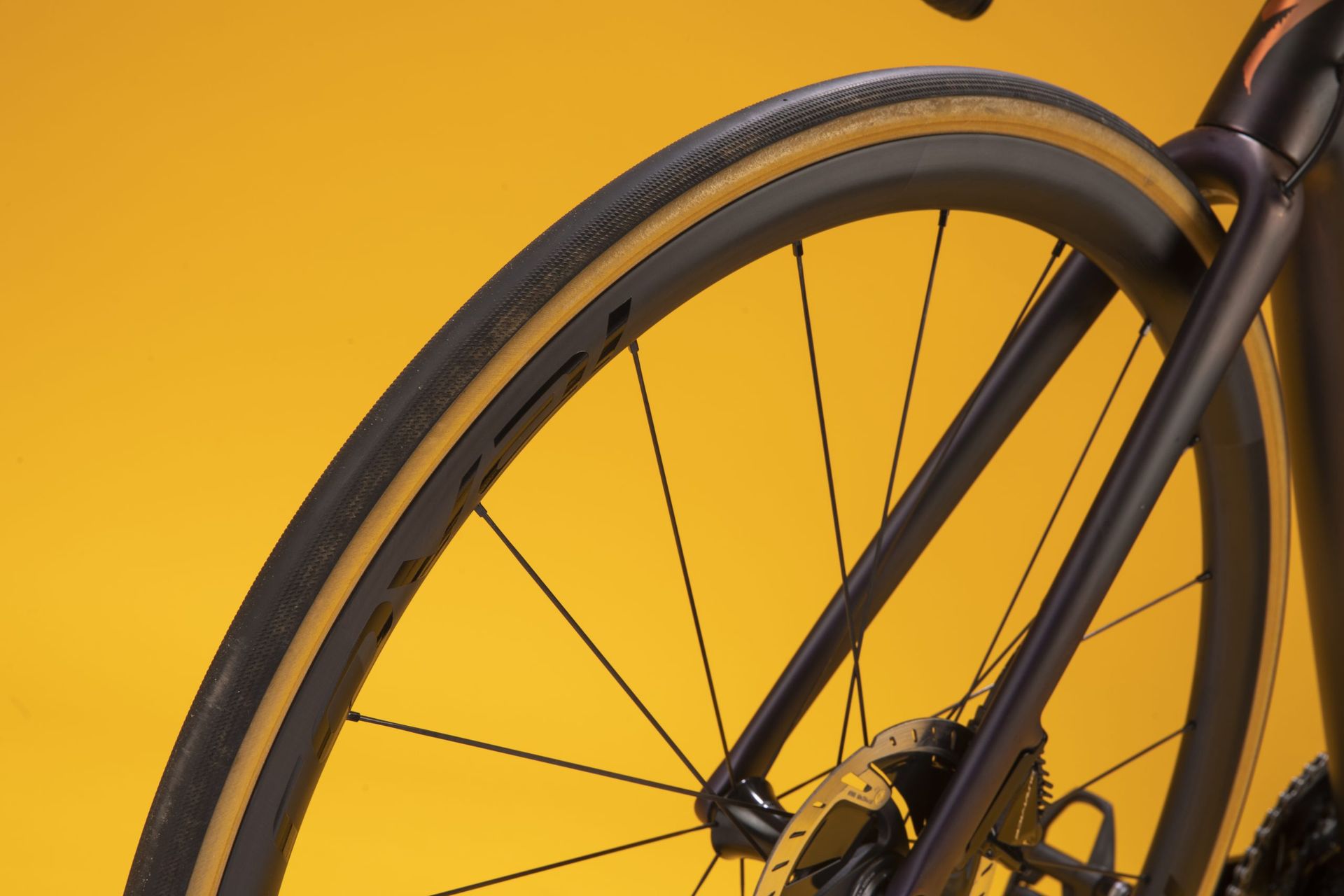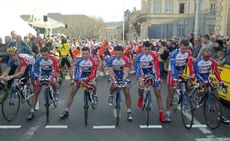Specialized Aethos review
The Aethos isn't designed for number pinning - but it certainly set our hearts racing
- (opens in new tab)
- (opens in new tab)
- (opens in new tab)
- Sign up to our newsletter Newsletter

Every time I climb onto the Aethos, it feels like coming home. The ride quality gave me everything I want from a bike. The rear end isn't quite as stiff as an out and out racer, and it's not aero - but I'd whack an aero bar on and a set of deep wheels and take it to a local race with no concern. Once I've come back down from cloud nine, I do have to look at the spec sheet alongside the RRP and point out that you could go fully custom and still have change left over. I also can't help but feel that Specialized has made a strange decision in replacing the Tarmac SL6 and Venge with the new aero Tarmac SL7 and Aethos. The SL6 had fantastic ride quality and was relatively aero, so feels almost like the ideal compromise. Despite all of that, the Aethos' design goal was to offer excellent ride quality with zero care for aerodynamics and it's achieve that in bucket loads. Yes, it's expensive - but it's also pioneering in being the lightest production disc brake frame in the world and that comes with a cost and the promise of trickle down tech for those currently priced out. I absolutely love this bike, of all the bikes I've tested this year it is the one that makes me want to stay out all day the most.
-
+
Ride quality x 100
-
+
Long term ease of maintenance
-
+
Traditional aesthetics
-
+
Low weight
-
-
If you want this plus aero, the SL6 might be on sale near you..
-
-
RRP deserves the Alpenist bar
Why you can trust Cycling Weekly Our expert reviewers spend hours testing and comparing products and services so you can choose the best for you. Find out more about how we test.

The Specialized S-Works Aethos was selected for an Editor's Choice award (opens in new tab) in 2020. This year's list contains 78 items which scored a 9 or 10/10 with our tech team - this gear is the best of the best, and has received the Cycling Weekly stamp of approval.
We must note that this bike was £10,750 at time of review, before a price rise saw it increase to £11,750. The model pictured was photographed ahead of testing, and the set-up is not as tested.
"I ride my bike to feel more alive... and this bike just does exactly that."
That was my first impression of the Specialized Aethos. In hindsight, it sounds a bit excessive - as I type my heart is pumping, my breath is breathing and there's no need to put an ad in the local newspaper just yet. However, I stand by the statement. The Aethos embodies how I want to feel when I ride a bike.
Specialized designed the Aethos as part of an experiment. Aim: design a bike thats sole purpose is to excel in ride quality. It's rare that I'll completely agree that a brand has met its remit - but honestly, I think the Aerthos has cracked it. If you ride for the love of riding, I'd wholeheartedly recommend this bike to you. As always, there are some caveats to this statement though...
The frame
The Aethos is extremely traditional in its aesthetic. Indeed, it looks like Specialized's own SL4. With its traditional round tubes and high seatstay bridge, it also reminds me of the Werking custom bike (opens in new tab) I had designed for me a couple of years ago.
However, the brand says this frame hasn't been pulled directly from the 1990s. We'd have to simply take their word for it, were it not for the weight: at 585g (for a barely painted) size 56. My size 52 has a claimed frame weight of 565g, plus about 25g for the Chameloen Red paintjob.

The stiffness to weight outperforms both Canyon's Ultimate CF Evo, using independent testers Zedler, and it also outperforms the Tarmac SL6 - so no need to be worried about floppyness. The max rider weight is 125kg - just like the brand's other frames, so it's not expected to crack - though this is an assessment for long term testing.
We have to trust the brand's description of how reached this industry lead setting stiffness to weight ratio. Reportedly, it used new tube shapes that are round but merge to become conical at key stress points, allowing for a reduction in carbon plies - check out the launch story for more detail on the manufacturing process.
The previous leading frame in the lightweight disc brake stakes was the Canyon Ultimate CF Evo - at 668g, according to the Zedler test, where my size XS was 5.98kg built. Whilst Specialized has taken a big chunk off the competition in terms of frame weight, this size 52 comes in at 5.95kg.
The lesser difference in built weight is because the American brand has bypassed some measures which would drop the mass - such as fitting a full carbon saddle. It's also used a threaded bottom bracket, which is heavier than press fit but makes home maintenance a lot easier.
The seatpost uses a standard 27.2 diameter, and the S-Works model comes with a two-piece bar and stem, with internal cable routing that disappears into the frame at the top tube and downtube, the cables are on show beneath the handlebars - again making maintenance easier.
The disc brakes are flat mount, and Specialized has made this bike compatible with 160mm rotors only - front and rear (due to a mixture of weight saving measures on the front fork and customer trends).
Geometry wise, though it's not being marketed as a 'race bike' (due to the Tarmac hitting the UCI weight limit and being more aerodynamic, thus faster), the Aethos shares most of its numbers with its World Tour winning sibling.

On my size 52, the wheelbase (975mm) and headangle (72.5º) match. The stack/reach look to be different (527/380 vs 517/382 on the SL7). However, this is mostly because the Tarmac has an unmovable spacer so the reality of the fit is identical - if you take the cockpit out of the equation.
Out on the bike, I felt that the size 52 Aethos was shorter vs the Tarmac. Measuring the tip of the saddle to the end of the shifter, I found it was, marginally. However, checking the headtube, top tube and bar reach, I couldn't establish why. In short - the geometry is very close, any small difference could be corrected via a stem swap.
If anything, I imagine my desire to be longer and more stretched out on the Aethos comes from my feeling more comfortable and at home one it, and feeling less fatigue running through my upper body. The body makes up 80 per cent of drag, so if being comfortable on a more springy frame means I can get longer and lower, I'm all for it and I'd be interested to test the science of which is actually faster.
Build
This S-Works Tarmac comes wearing Shimano Dura Ace Di2 (with dual sided power meter). Of course, it shifts excellently and the brakes are responsive. Personally, I prefer SRAM Red eTap in the 'lecky gears' stakes, but notably SRAM is a few hundred grams heavier. So the Di2 fits the lightweight build.
The Power Arc saddle is a practical choice, and whilst it's not my favourite, I've yet to find anyone who finds the Power a real pain in the bum - so it's an excellent choice for an all-round bottom pleaser.
The 'short and shallow' carbon bars feel great on the drops - I really enjoyed having a standard, traditional bar in my grip. I would like the reach to be a little longer, but I could fix that with a stem swap.
I do think the alloy stem and spacers - which are wider in diameter - ruin the look of this bike a bit. The Roval Alpenist handlebar (opens in new tab) recently released would create a cleaner look, in my opinion.

The Alpenist wheels in 33m diameter work perfectly with this bike, and 26mm Turbo Cotton tyres are a treat - though neither is tubeless ready which seems like a major omission in 2020. This said, Specialized had riders running clinchers and latex tubes at the Tour de France, so perhaps tubeless isn't the only way to go as has been frequently touted as of late.
This build comes in at £11,750 (£10,750 at time of review). Sure, the frame is record breaking. However, I can't help but point out that you could build a bike entirely to your own specifications via a custom builder, for less. You wouldn't get a 585g frame, but you would likely get a responsive and lively ride quality, and a custom geometry.
The ride
Riding the Aethos away from my home in Caterham Valley, I've never smiled so widely at passing cyclists.
Whilst aero race bikes are undeniably fast, and from a technical perspective, I can't knock them, they numb a little bit of the enjoyment of cycling for me. The Aethos brought everything I've been crying out for - somewhat vocally - all year.
Every pedal stroke feels determined and effective in providing forward momentum - much more so than on an aero bike. I realise this goes against physics, and it's an impossibility - the aero bike will require fewer watts for the same effect. But it doesn't feel as good.
Nailing into corners, this bike seems to move with me - like an extension of my body, as opposed to a machine that I'm driving. I'd put this down to the extra lateral flex afforded by this frame shape.
The Aethos does feel a bit softer at the rear end when compared with a more aero bike, like the Tarmac SL7. However, over the course of a long ride, I found the extra compliance an asset - but this will be down to personal preference. The front end is definitely stiff enough and offers excellent transmission to the road creating a directness that I loved.
It's pretty hard to put a number on exactly how many watts you're losing in aerodynamics. My experience so far has been that this bike is still fast - it's just not necessarily a PB setter.
For comparison's sake, I did my standard test loop on the Aethos, riding at a sub-tempo, day-to-day pace. It's 53km/33 miles with 713 metres/2339 feet of Kentish climbing. On the Aethos, I averaged 29.4kph/18.2mph. It was a notably windy day. My average power was 170watts; I didn't set a single PR on a segment. Comparatively, the same route on the Tarmac SL7, I averaged 28.6kph/17.7mph at 172 watts, but I did pick up a couple of segment PRs.
I have to stress that this is not a controlled experiment in any way - these were different weather conditions. The aerodynamics of the Tarmac SL7 certainly showed when I raced myself on a time trial circuit, at 230watts/22mph/34kph and the benefit would increase with speed. The takeaway is that I would not expect your average speed to drop by a lot on your daily rides due to this bike's lack of aero features. You would lose the edge during race efforts - but then, that's not what the Aethos is for.
On the Sunday club run, I felt like I was in the form of my life riding this bike, and notably it was pointed out that I seemed to be the strongest of the day as we rounded the route off.

The race feel and non-aero nature of this bike could arguably limit the Aethos' appeal. However, not necessarily so when you look at the number of cyclists who jump on their bikes every weekend for the pure, unadulterated joy of pedalling.
If all you want is to win races, the SL7 is the sensible choice. If you want phenomenal ride quality to boot, personally, I'd recommend the SL6. If I was spending my money, that's what I'd do. However, there are a lot of riders out there to whom racing is irrelevant. If that's you, then the Aethos could be for you, too.
Value
The S-Works model of this bike comes in at £11,750. At time of review, it was £10,750. Either way, that's expensive, you could see a custom frame builder and get something made to measure for less.
However, this frame was three years in the making. It is the lightest disc brake frame on the market, and trickle down technology benefits the entire market. In fact, Specialized says that leanings from this frame did influence that of the Tarmac SL7 and its recent Epic mountain bike launch. That doesn't help you if you're counting your pennies and can't make them stretch this far. What might help you is the knowledge that the Aethos will be a product family, and therefore we can expect lower spec options to arrive soon.
With those comments in mind, my only really quibble with the prize is that I personally think that a customer burning £11,750 would be in their right to want the neater looking Alpenist handlebar.

Thank you for reading 10 articles this month* Join now for unlimited access
Enjoy your first month for just £1 / $1 / €1
*Read 5 free articles per month without a subscription

Join now for unlimited access
Try first month for just £1 / $1 / €1
Michelle Arthurs-Brennan is a traditional journalist by trade, having begun her career working for a local newspaper, where highlights included interviewing a very irate Freddie Star (and an even more irate theatre owner), as well as 'the one about the stolen chickens'.
Previous to joining the Cycling Weekly team, Michelle was Editor at Total Women's Cycling. She joined CW as an 'SEO Analyst', but couldn't keep her nose out of journalism and in the spreadsheets, eventually taking on the role of Tech Editor before her latest appointment as Digital Editor.
Michelle is a road racer who also enjoys track riding and the occasional time trial, though dabbles in off-road riding too (either on a mountain bike, or a 'gravel bike'). She is passionate about supporting grassroots women's racing and founded the women's road race team 1904rt.
Michelle is on maternity leave from July 8 2022, until April 2023.
-
 Closing the gap: David Gaudu emerges from Paris-Nice more confident than ever before
Closing the gap: David Gaudu emerges from Paris-Nice more confident than ever beforeThe Groupama-FDJ rider finished second overall at the Race to the Sun, but gained more than just the result
By Adam Becket • Published
-
 Goodbye lime: We need to talk about the Tour de France green jersey
Goodbye lime: We need to talk about the Tour de France green jerseyThere's change afoot at ASO's French races, with the combativity colour also undergoing a revamp
By Adam Becket • Published
-
 Andrei Kivilev remembered 20 years on from his death at Paris-Nice
Andrei Kivilev remembered 20 years on from his death at Paris-NiceKazakh rider’s death during 2003 edition led to helmets being made obligatory in racing
By Peter Cossins • Published


